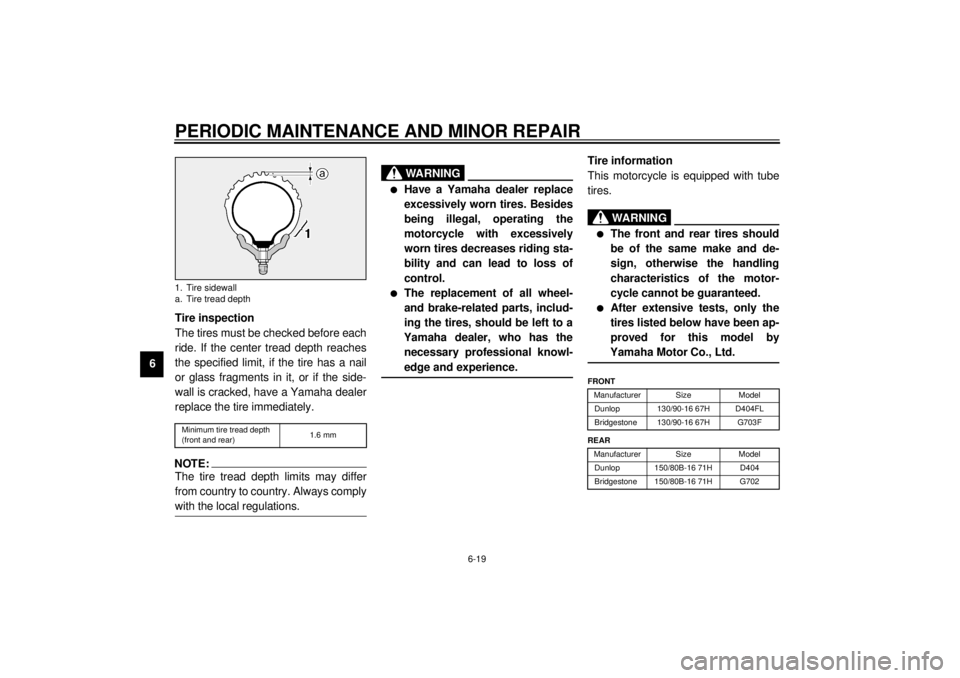Page 57 of 104

PERIODIC MAINTENANCE AND MINOR REPAIR
6-12
6
EAU03395
Transfer case oil The transfer case oil level should be
checked before each ride. In addition,
the oil must be changed at the intervals
specified in the periodic maintenance
and lubrication chart.
To check the transfer case oil level
1. Place the motorcycle on a level
surface and hold it in an upright
position.
NOTE:@ Make sure that the motorcycle is posi-
tioned straight up when checking the oil
level. A slight tilt to the side can result in
a false reading. @2. Remove the oil check bolt, and
then check the oil level in the
transfer case.NOTE:@ The oil should be at the brim of the
check hole. @3. If the oil is below the brim of the
check hole, remove the oil filler
cap, add sufficient oil of the rec-
ommended type to raise it to the
correct level, and then install the
oil filler cap.
4. Install the oil check bolt, and then
tighten it to the specified torque.To change the transfer case oil
1. Place an oil pan under the transfer
case to collect the used oil.
2. Remove the drain bolt and the
check bolt to drain the oil from the
transfer case.
3. Install the drain bolt and the check
bolt, and then tighten the drain bolt
to the specified torque.
1. Transfer case oil filler cap
2. Transfer case oil check bolt
Tightening torque:
Transfer case oil check bolt:
7.5 Nm (0.75 m·kg)
1. Transfer case oil drain boltTightening torque:
Transfer case oil drain bolt:
17.5 Nm (1.75 m·kg)
E_5JA.book Page 12 Wednesday, September 13, 2000 6:06 PM
Page 58 of 104
PERIODIC MAINTENANCE AND MINOR REPAIR
6-13
64. Remove the oil filler cap, add the
specified amount of the recom-
mended transfer case oil, and then
install and tighten the oil filler cap.
ECA00024
CAUTION:@ Make sure that no foreign material
enters the transfer case. @
5. Start the engine and let it idle for
several minutes while checking
the transfer case for oil leakage. If
oil is leaking, immediately turn the
engine off and check for the
cause.
EAU03707
Cleaning the air filter element The air filter element should be cleaned
at the intervals specified in the periodic
maintenance and lubrication chart.
Clean the air filter element more fre-
quently if you are riding in unusually
wet or dusty areas.
1. Remove the air filter case bolts.
1. Transfer case oil check holeRecommended transfer case oil:
See page 8-2.
Oil quantity:
0.4 L
1. Bolt (´ 4)
2. Air filter case
E_5JA.book Page 13 Wednesday, September 13, 2000 6:06 PM
Page 59 of 104
PERIODIC MAINTENANCE AND MINOR REPAIR
6-14
6 2. Loosen the air filter joint clamp
screw, and then slightly pull the air
filter case out.3. Remove the air filter case cover by
removing the screws.
4. Disconnect the hoses shown.5. Remove the air filter element by
removing the screws, and then
disconnect the hose shown.
1. Air filter joint clamp screw
1. Screw (´ 2)
2. Hose (´ 2)
3. Air filter case cover
1. Screw (´ 2)
2. Hose
E_5JA.book Page 14 Wednesday, September 13, 2000 6:06 PM
Page 60 of 104
PERIODIC MAINTENANCE AND MINOR REPAIR
6-15
66. Lightly tap the air filter element to
remove most of the dust and dirt,
and then blow the remaining dirt
out with compressed air as shown.
If the air filter element is damaged,
replace it.7. Install the air filter element by in-
serting it into the air filter case,
then installing the screws, and
then connect the hose shown.
8. Install the air filter case cover by
installing the screws.9. Connect the hoses shown.
10. Install the air filter case by pushing
it onto the air filter joint, and then
tighten the air filter joint clamp
screw.
11. Install the air filter case by install-
ing the bolts.
1. Screw (´ 2)
2. Hose
1. Hose (´ 2)
E_5JA.book Page 15 Wednesday, September 13, 2000 6:06 PM
Page 61 of 104

PERIODIC MAINTENANCE AND MINOR REPAIR
6-16
6
EAU00629
Adjusting the carburetor The carburetor is an important part of
the engine and requires very sophisti-
cated adjustment. Therefore, most car-
buretor adjustments should be left to a
Yamaha dealer, who has the neces-
sary professional knowledge and expe-
rience. The adjustment described in
the following section, however, may be
serviced by the owner as part of routine
maintenance.
EC000094
CAUTION:@ The carburetor has been set and ex-
tensively tested at the Yamaha fac-
tory. Changing these settings
without sufficient technical knowl-
edge may result in poor perfor-
mance of or damage to the engine. @
EAU01168
Adjusting the engine idling
speed The engine idling speed must be
checked and, if necessary, adjusted as
follows at the intervals specified in the
periodic maintenance and lubrication
chart.NOTE:@ A diagnostic tachometer is needed to
make this adjustment. @1. Attach the tachometer to the spark
plug lead.
2. Start the engine and warm it up for
several minutes at 1,000–
2,000 r/min while occasionally rev-
ving it to 4,000–4,400 r/min.NOTE:@ The engine is warm when it quickly re-
sponds to the throttle. @
3. Check the engine idling speed
and, if necessary, adjust it to spec-
ification by turning the throttle stop
screw. To increase the engine
idling speed, turn the screw in di-
rection
a. To decrease the engine
idling speed, turn the screw in di-
rection
b.NOTE:@ If the specified idling speed cannot be
obtained as described above, have a
Yamaha dealer make the adjustment. @1. Throttle stop screwEngine idling speed:
850–950 r/min
E_5JA.book Page 16 Wednesday, September 13, 2000 6:06 PM
Page 62 of 104
PERIODIC MAINTENANCE AND MINOR REPAIR
6-17
6
EAU00635
Adjusting the throttle cable
free play The throttle cable free play should
measure 4–6 mm at the throttle grip.
Periodically check the throttle cable
free play and, if necessary, have a
Yamaha dealer adjust it.
EAU00637
Adjusting the valve clearance The valve clearance changes with use,
resulting in improper air-fuel mixture
and/or engine noise. To prevent this
from occurring, the valve clearance
must be adjusted by a Yamaha dealer
at the intervals specified in the periodic
maintenance and lubrication chart.
EAU01848
Tires To maximize the performance, durabil-
ity, and safe operation of your motor-
cycle, note the following points
regarding the specified tires.
Tire air pressure
The tire air pressure should be
checked and, if necessary, adjusted
before each ride.
a. Throttle cable free playE_5JA.book Page 17 Wednesday, September 13, 2000 6:06 PM
Page 63 of 104

PERIODIC MAINTENANCE AND MINOR REPAIR
6-18
6
EW000082
WARNING
@ l
The tire air pressure must be
checked and adjusted on cold
tires (i.e., when the temperature
of the tires equals the ambient
temperature).
l
The tire air pressure must be
adjusted in accordance with the
riding speed and with the total
weight of rider, passenger, car-
go, and accessories approved
for this model.
@CE-01E
CE-07EEWA00012
WARNING
@ Because loading has an enormous
impact on the handling, braking,
performance and safety characteris-
tics of your motorcycle, you should
keep the following precautions in
mind. l
NEVER OVERLOAD THE
MOTORCYCLE! Operation of an
overloaded motorcycle may re-
sult in tire damage, loss of con-
trol, or severe injury. Make sure
that the total weight of rider,
passenger, cargo, and accesso-
ries does not exceed the speci-
fied maximum load for the
vehicle.
l
Do not carry along loosely
packed items, which can shift
during a ride.
l
Securely pack the heaviest
items close to the center of the
motorcycle and distribute the
weight evenly on both sides.
l
Adjust the suspension and tire
air pressure with regard to the
load.
l
Check the tire condition and air
pressure before each ride.
@
Tire air pressure
(measured on cold tires)
Load* Front Rear
Up to 90 kg250 kPa
2.50 kg/cm
2
2.50 bar250 kPa
2.50 kg/cm
2
2.50 bar
90 kg–maximum250 kPa
2.50 kg/cm
2
2.50 bar280 kPa
2.80 kg/cm
2
2.80 bar
Maximum load* 196 kg
* Total weight of rider, passenger, cargo and
accessories
E_5JA.book Page 18 Wednesday, September 13, 2000 6:06 PM
Page 64 of 104

PERIODIC MAINTENANCE AND MINOR REPAIR
6-19
6Tire inspection
The tires must be checked before each
ride. If the center tread depth reaches
the specified limit, if the tire has a nail
or glass fragments in it, or if the side-
wall is cracked, have a Yamaha dealer
replace the tire immediately.
CE-08ENOTE:@ The tire tread depth limits may differ
from country to country. Always comply
with the local regulations. @
EW000079
WARNING
@ l
Have a Yamaha dealer replace
excessively worn tires. Besides
being illegal, operating the
motorcycle with excessively
worn tires decreases riding sta-
bility and can lead to loss of
control.
l
The replacement of all wheel-
and brake-related parts, includ-
ing the tires, should be left to a
Yamaha dealer, who has the
necessary professional knowl-
edge and experience.
@
Tire information
This motorcycle is equipped with tube
tires.
EW000078
WARNING
@ l
The front and rear tires should
be of the same make and de-
sign, otherwise the handling
characteristics of the motor-
cycle cannot be guaranteed.
l
After extensive tests, only the
tires listed below have been ap-
proved for this model by
Yamaha Motor Co., Ltd.
@CE-10E
1. Tire sidewall
a. Tire tread depthMinimum tire tread depth
(front and rear)1.6 mm
FRONT
Manufacturer Size Model
Dunlop 130/90-16 67H D404FL
Bridgestone 130/90-16 67H G703F
REAR
Manufacturer Size Model
Dunlop 150/80B-16 71H D404
Bridgestone 150/80B-16 71H G702
E_5JA.book Page 19 Wednesday, September 13, 2000 6:06 PM
 1
1 2
2 3
3 4
4 5
5 6
6 7
7 8
8 9
9 10
10 11
11 12
12 13
13 14
14 15
15 16
16 17
17 18
18 19
19 20
20 21
21 22
22 23
23 24
24 25
25 26
26 27
27 28
28 29
29 30
30 31
31 32
32 33
33 34
34 35
35 36
36 37
37 38
38 39
39 40
40 41
41 42
42 43
43 44
44 45
45 46
46 47
47 48
48 49
49 50
50 51
51 52
52 53
53 54
54 55
55 56
56 57
57 58
58 59
59 60
60 61
61 62
62 63
63 64
64 65
65 66
66 67
67 68
68 69
69 70
70 71
71 72
72 73
73 74
74 75
75 76
76 77
77 78
78 79
79 80
80 81
81 82
82 83
83 84
84 85
85 86
86 87
87 88
88 89
89 90
90 91
91 92
92 93
93 94
94 95
95 96
96 97
97 98
98 99
99 100
100 101
101 102
102 103
103






